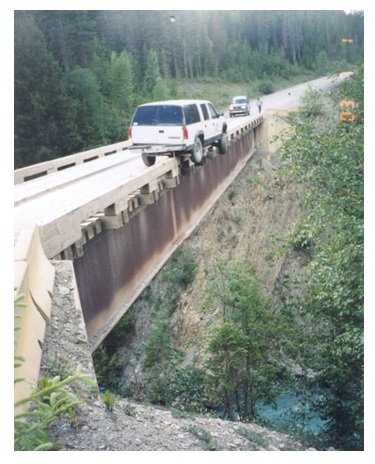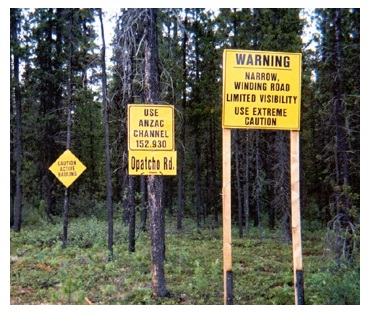|
2004
The Range of Radio Frequencies
By: Ritinder Harry
|

This picture depicts a single lane bridge
over a gorge that is typical of many logging roads in BC. This person had
a very close call!
|
When we think of the logging or mining
industries here in BC, radio frequencies are generally not one of the
first things that come to mind. But, believe it or not, the use of
radiocommunications has been a key contributor to economic growth in these
resource industries.
“To logging or mining truck drivers who travel to remote sites all over
the province, radios are essential as they coordinate road safety,”
explains
Morris Bodnar, District Manager of the Northern BC and Yukon
office.
In areas where logging, mining or oil and gas exploration occurs, narrow
and unpaved roads are used to haul product or equipment in and out of work
sites. These winding roads can be very dangerous with limited visibility. Morris explains that in order to safely navigate their route, loggers,
truckers and other motorists need to have access to a particular frequency
on their radios. “If another vehicle is using the same route, the radio
will be used to warn you of an oncoming vehicle, providing sufficient time
to pull out safely.”
Problems arise when drivers travel to areas where different road
frequencies are used, sometimes finding out too late that the posted radio
frequency is not installed in their radio.
|

Some of the signs you would find along
these roads warning of dangerous conditions and the radio frequency in use
in that area.
|
“With the steady growth in these industries over the past four decades and the
ever increasing number of roads needing a new frequency, finding
interference-free new assignments for road safety communications is like trying
to find the next piece of your jigsaw puzzle,” explains Morris .
The numerous frequency assignments used by the trucking industry have
resulted in interference to other authorized radio users, including
police, fire and emergency services. This, because truckers travel large
geographic areas, sometimes encompassing several provinces.
Morris, along with
Gord Hermann, Manager of the Kelowna District office,
is working on a major reorganization of radio frequencies used for road
safety communications. Upon completion, this project will reduce the
number of different frequencies needed in a logging/mining truck radio by
allocating a block of frequencies specifically for road safety.
This interprovincial project first began in October 2003, when a working
group was established consisting of IC representatives from the Prince
George, Kelowna, Surrey, Victoria, Calgary, and Edmonton District
offices.
The project is currently in a consultation phase with stakeholders and
equipment suppliers, with feedback being extremely positive. Morris
explains that “achieving our goal of designating exclusive spectrum for
this purpose will make it easier for loggers and truckers to find the
right road frequency, virtually eliminating the need to have 100 or more
frequencies installed on their radios.”
Morris believes this project is necessary and “will help Industry Canada
better manage the radio spectrum - it’s going to be a win-win situation.”
|

